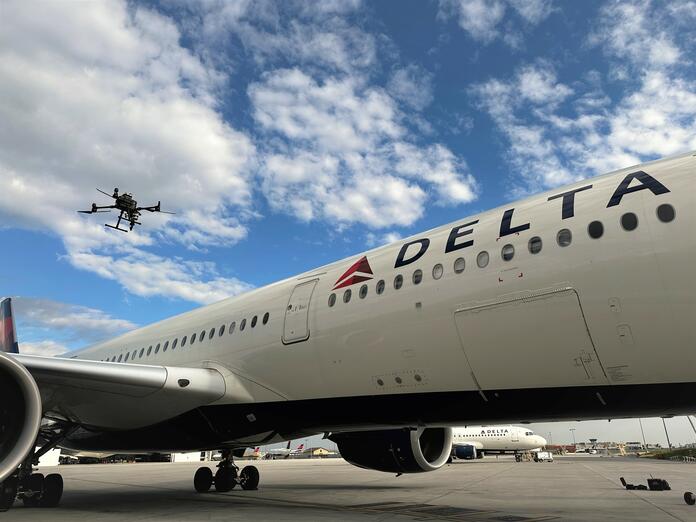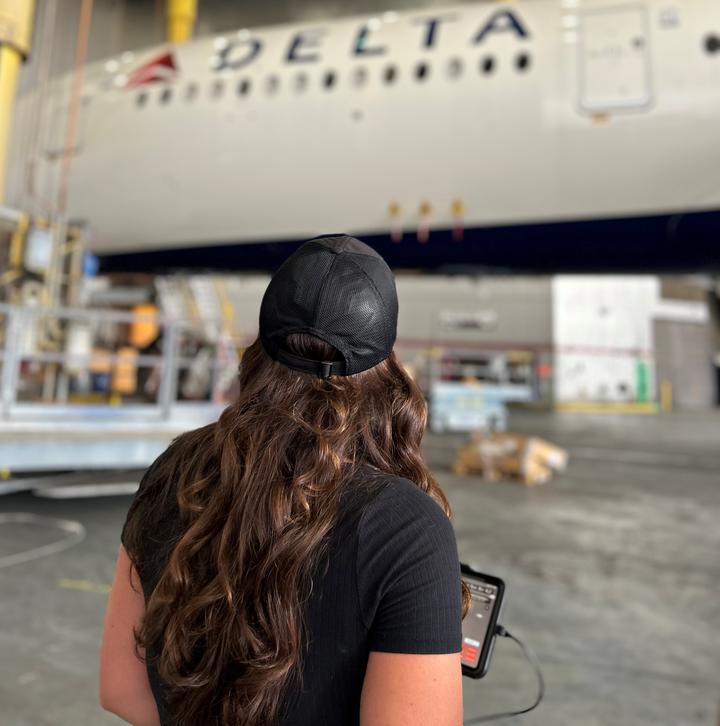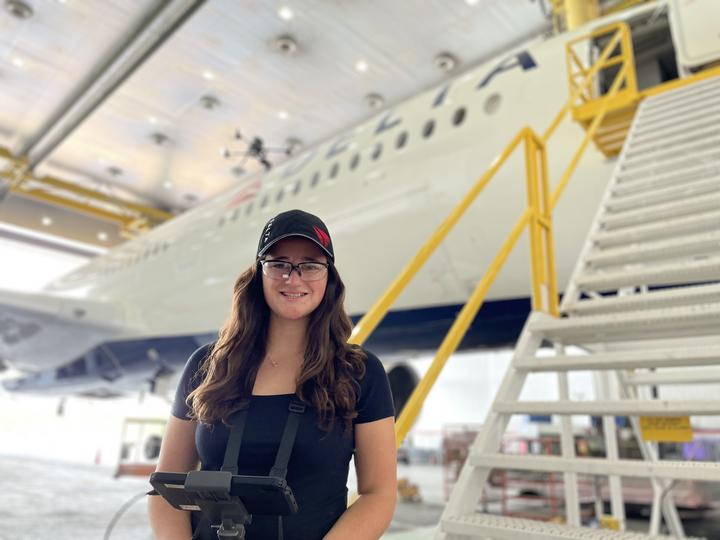I fly drones at Delta: The story of an airline pilot unlike any other
Among Delta’s 90,000 employees around the world, there are many whose work behind the scenes contribute to Delta’s success. One example is Emma Galarza, a senior engineer with Delta TechOps who works on drone technology that will not only help make aircraft maintenance inspections more efficient but safer for our people.

Inside the cavernous expanse of a Delta maintenance hangar, just steps away from the bustling runways of Atlanta’s airport, an autonomous drone takes off for a test flight. The drone climbs and then carefully hovers alongside the Delta Widget emblazoned on the side of an Airbus A350-900, commencing an inspection of Delta’s state-of-the-art flagship jet. Overseeing the drone is Emma Galarza, a senior engineer with Delta TechOps, the division of Delta responsible for aircraft repair and maintenance. Galarza, one of a handful of drone pilots at Delta TechOps, is a member of the Technology Development team working on autonomous drone technology to help make aircraft maintenance more efficient and safer for our people without compromising the quality of the result.
Delta’s core mission is to provide customers with a safe, reliable travel experience accompanied by service with an elevated flair. Our ability to deliver on that promise hinges on each of Delta’s 90,000 global employees contributing toward a singular goal. Most Delta fliers' experiences with our people are limited to a handful of public-facing positions such as our pilots, flight attendants and customer service agents. But tens of thousands of our people, such as Galarza, work behind-the-scenes to help ensure Delta is at our best for our customers and fellow employees.
The Tampa, Fla. native has always been fascinated by new technology and how human interaction is factored into its design. However, it was during a year-long co-op with Delta TechOps, while in college at the Georgia Institute of Technology, that she was inspired to apply her interest in aviation.
“I’ve always had a curiosity about how things and why things work, but it was through working for Delta that I found my passion for aerospace,” Galarza said.
During her year with Delta, Galarza researched to evaluate which advanced technologies could be adapted for use at the airline and how we could deploy them. Among the technologies featured in her research, drones.
After nearly half a decade away, Galarza rejoined the Delta family in January.
“Coming back to Delta was absolutely the highlight of my career,” the mechanical engineer said. “When the opportunity came up, it was no question asked. I’m here in a second.”
For Galarza, the big draw was Delta’s culture and the chance to work with many of the same colleagues and leaders from her time as a co-op.
“The Delta culture is unique in that you have so many incredibly smart people here, but there is an air of true humility,” she said. “People just want to help you do your job better and help us fly safer and more reliably for our customers.”
“Everyone works hand-in-hand for the same end goal,” Galarza added.
The task Galarza and her colleagues have undertaken embodies this collaborative culture.
The work of inspecting an airliner for damage or imperfections is slow, tedious and requires meticulous attention to detail. It’s work traditionally dependent on a keen human eye to carefully examine every inch of an aircraft’s exterior. This means inspections often require our people to spend hours physically on or harnessed high above an aircraft.
A manual inspection of a wide-body jet like the Airbus A350-900, which is nearly 220 feet long and, at its tallest point, is the height of a four-story building, can take as long as 16 hours. The autonomous drones can capture high-definition images of the aircraft for inspectors on the ground to evaluate in just 90 minutes, thereby expediting the process while mitigating the safety risk.
“These drones are not here to replace our people, they are here as tools to help them,” Galarza reiterated.
In addition, the team believes its work has the potential to help Delta’s maintenance and repair operation become more efficient by using quick drone inspections to help technicians properly prioritize and streamline the schedule for aircraft repair, limiting any disruptions to flight operations.
The TechOps team operates a fleet of two drones, named Reba and Dolly, in cooperation with the drones’ manufacturer as a technology partner. The team has programmed the drones to recognize each aircraft type in the Delta fleet and can scan each aircraft autonomously under the supervision of a drone pilot who takes control only in case of emergency.
Delta has approval from regulators to fly the drones indoors and outdoors at its maintenance facilities in Atlanta, Detroit and Minneapolis, but is currently limited to non-safety critical inspection work such as looking for paint blemishes.
The team is conducting test flights with the hope of receiving federal regulators' approval to expand its drones' role. In fact, much of Galarza’s work is focused on developing and implementing the programs that allow the drone’s high-definition cameras to be used for more critical aircraft inspections.
As for Galarza, these drones are just the beginning of her work with the airline. She’s on the lookout for the next technology that can be added to Delta’s toolbox.
“It’s a unique opportunity as an engineer to work with and learn from our people in the hangar, many of whom have decades of experience,” she said. “I am always looking for ways we can integrate new technology into our airline.”


